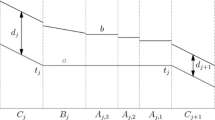Abstract
The maximal correlation is an attractive measure of dependence between the components of a random vector, however it presents the difficulty that its calculation is not easy. Here, we consider the case of bivariate vectors which components are order statistics from discrete distributions supported on \(N\ge 2\) points. Except for the case \(N=2\), the maximal correlation does not have a closed form, so we propose the use of a gradient based optimization method. The gradient vector of the objective function, the correlation coefficient of pairs of order statistics, can be extraordinarily complicated and for that reason an automatic differentiation algorithm is proposed.





Similar content being viewed by others
References
Arnold BC, Balakrishnan N, Nagaraja HN (2008) A first course in order statistics. Society for Industrial and Applied Mathematics, Philadelphia
Baydin AG, Pearlmutter BA, Radul A, Siskind JM (2017) Automatic differentiation in machine learning: a survey. J Mach Learn Res 18:1–43
Breiman L, Friedman JH (1985) Estimating optimal transformations for multiple regression and correlation. J Am Stat Assoc 80(391):580–619
Bryc W, Dembo A, Kagan A (2005) On the maximum correlation coefficient. Theory Probab Appl 49(1):132–138
David HA, Nagaraja HN (2004) Order statistics. Wiley, New York
Dembo A, Kagan A, Shepp LA (2001) Remarks on the maximum correlation coefficient. Bernoulli 7(2):343–350
Gebelein H (1941) Das Statistische Problem der Korrelation als Variations und Eigenwertproblem und sein Zusammenhang mit der Ausgleichsrechnung. Z Angew Math Mech 21(6):364–379
Griewank A, Walther A (2008) Evaluating derivatives, 2nd edn. Society for Industrial and Applied Mathematics (SIAM), Philadelphia
Lancaster HO (1957) Some properties of the bivariate normal distribution considered in the form of a contingency table. Biometrika 44(1–2):289–292
Liu JS, Wong WH, Kong A (1994) Covariance structure of the Gibbs sampler with applications to the comparisons of estimators and augmentation schemes. Biometrika 81(1):27–40
López-Blázquez F, Castaño-Martínez A (2006) Upper and lower bounds for the correlation ratio of order statistics from a sample without replacement. J Stat Plan Inference 136(1):43–52
López-Blázquez F, Salamanca-Miño MB (1999) On Terrel’s characterization of uniform distribution. Stat Papers 40(3):335–342
López-Blázquez F, Salamanca-Miño B (2014) Maximal correlation in a non-diagonal case. J Multivar Anal 131:265–278
Papadatos N, Xifara T (2013) A simple method for obtaining the maximal correlation coefficient and related characterizations. J Multivar Anal 118:102–114
Székely GJ, Móri TF (1985) An extremal property of rectangular distributions. Stat Probab Lett 3(2):107–109
Terrel GR (1983) A characterization of rectangular distributions. Ann Probab 11(3):823–826
Yu Y (2008) On the maximal correlation coefficient. Stat Probab Lett 78(9):1072–1075
Acknowledgements
This work was supported by Grant MTM2016-74983-C2 of the Spanish Ministry of Economy and Competitiveness, Grant FQM331 of Junta de Andalucía and the Complex networks meet data science project financed by Fundación BBVA.
Author information
Authors and Affiliations
Corresponding author
Additional information
Publisher's Note
Springer Nature remains neutral with regard to jurisdictional claims in published maps and institutional affiliations.
Rights and permissions
About this article
Cite this article
López-Blázquez, F., Salamanca-Miño, B. Automatic differentiation and maximal correlation of order statistics from discrete parents. Comput Stat 36, 2889–2915 (2021). https://doi.org/10.1007/s00180-021-01103-5
Received:
Accepted:
Published:
Issue Date:
DOI: https://doi.org/10.1007/s00180-021-01103-5



